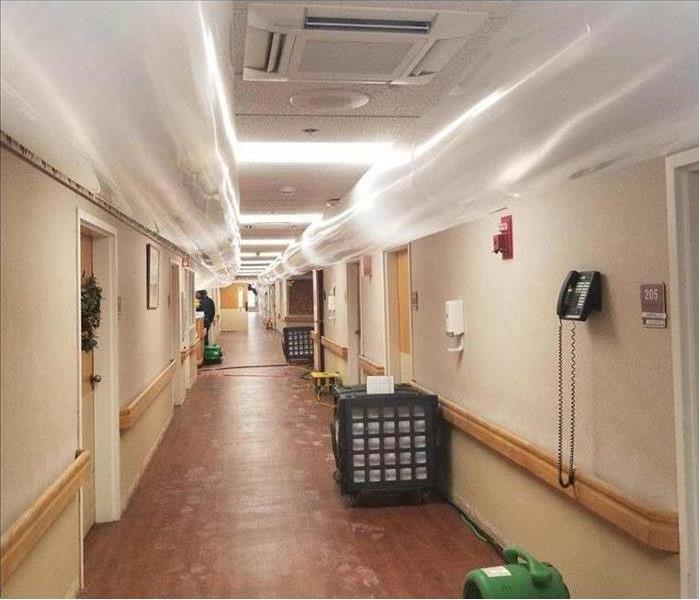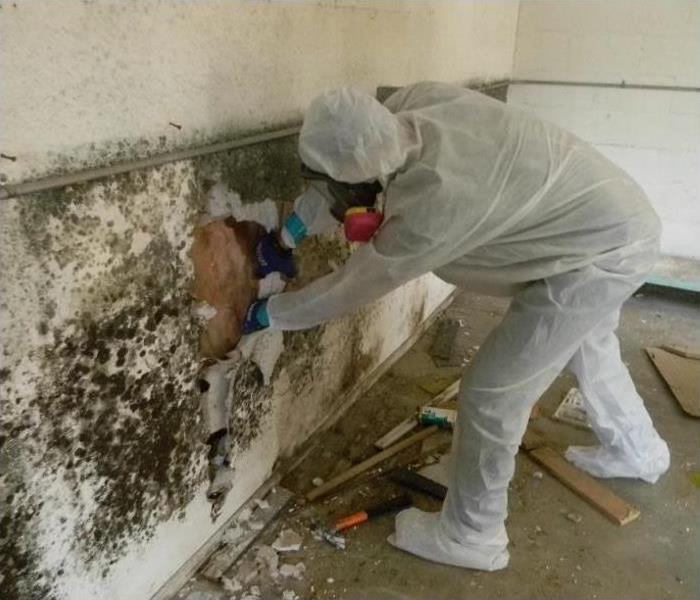Recent Mold Remediation Posts
Water and Mold Restoration Services for Medical Facilities
8/23/2023 (Permalink)
When water damage occurs at a medical facility, our team knows that the stakes are high.
When we arrive at the hospital or medical complex, our job will entail not only the typical scope of water damage restoration but also the protection of expensive medical equipment and documents.
For example, a common scenario that we encounter in our work is a water sprinkler setting off, either due to a damaged pipe or a malfunction in a hospital. Sprinkler systems in commercial buildings can release thousands of gallons of water over everything in the facility, causing massive water damage. When we arrive on the scene, we immediately implement a plan for protecting valuable equipment and documents. Not only is it vital to relocate equipment, but drying it out to make sure no further damage occurs is also a priority.
We have the training and the equipment to do our jobs efficiently and correctly. Our team is on call 24/7 so that we can respond to situations like flooding in medical facilities immediately.
You give your patients 100%. We will do the same for your facility.
When are Professional Mold Remediation Services Needed?
6/21/2021 (Permalink)
With all of the attention and media coverage about household mold, and its associated health effects, the office staff at SERVPRO of Southbury/Torrington often field phone calls from concerned homeowners who have discovered mold in their home.
Unfortunately, the internet is full of misinformation on what is effective and safe mold removal - such as the misconception that bleach kills mold (it does not). While there are some cases where a small area of mold on a non-porous surface can be effectively cleaned by a homeowner themselves, we recommend having a SERVPRO IICRC trained professional come and inspect your home. Our team has decades of experience and training that they use to identify your mold situation and advise you on a course of action.
Mold spores are microscopic, float along in the air, and may enter your home through windows, doors, or AC/heating systems or even hitch a ride indoors on your clothing or a pet. A homeowner may have cleaned all visible evidence of mold from a hard surface yet not know the level of mold spores in the air and how it is affecting their home and their health. Mold spores also root into porous surfaces such as carpeting, wood and sheet rock walls and ceilings. So if you scrub down black mold on your windowsill, the mold might appear to have been removed but actually is still present inside of the wood and will reappear.
Mold is a sign that there is a problem in your home. Whether it's a leaky pipe behind a wall that you can't see, water behind some boxes in your basement or inadequate venting in your attic that is causing high humidity, the cause of the mold in your home is something that needs to be addressed.
Give us a call if you spot mold in your home. We will schedule an appointment for one of our mold specialists to come out to your house, survey the situation and give you an honest opinion of what action needs to be taken.
Warped or Discolored Walls? Musty Smell in Your Home? It Could be Mold.
6/24/2020 (Permalink)
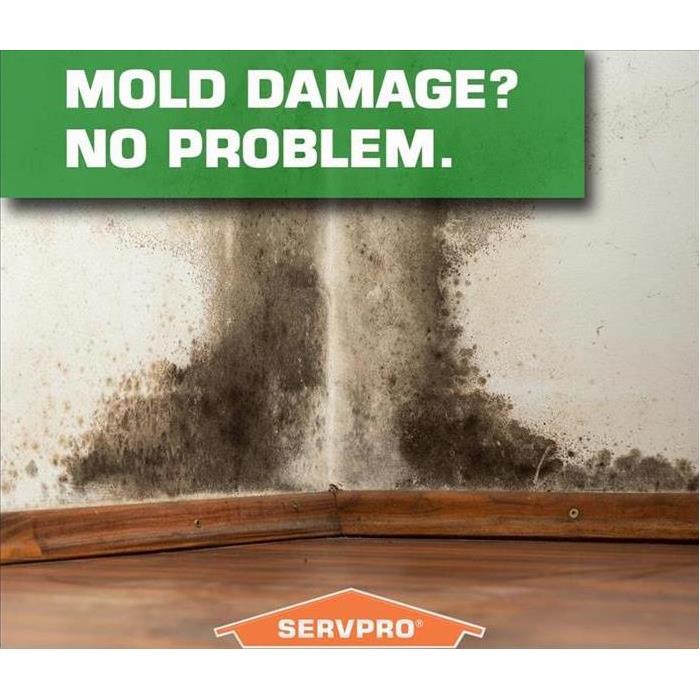 Sometimes mold is obvious, as in this photo. Other times, the signs are subtle.
Sometimes mold is obvious, as in this photo. Other times, the signs are subtle.
It's not always obvious when your home has hidden mold. Unlike water or fire damage, mold damage can occur slowly and behind the walls of your home or business.
If your home has had water damage, it is likely that mold will start to grow in your walls or ceilings within 48 hours if the water wasn't removed. Drywall in particular will absorb water like a sponge very quickly and is an ideal surface for mold to grow on. If water damage in your home has soaked into your drywall, removal of the drywall is necessary to stop the possibility of mold growth. If your home has a slow leaking pipe, it could cause moist conditions behind your walls, allowing mold to grow.
There are some signs of mold that you you should be aware of.
- Damp or soft walls - Inspect your walls for any softness of the sheetrock, which could happen when it is deteriorating from the inside. Also, if your walls for damp to the touch, the cause should be determined.
- Warped walls - If your walls are bulging or warped, that could indicate moisture.
- Discoloration – Yellow, brown or black stains or rings on your walls are a sign of water damage from behind them.
- Peeling, bubbling or cracking of paint or wallpaper. We recently restored a home that had water damage in Milford, CT. The home had a hot water heater burst in the basement and although the water damage was discovered within 2 days, mold had begun to grow behind the wallpaper.
- Musty Smell - If you don’t see signs of mold but you can smell it, it may be hidden in your walls. The best way to describe a mold smell is that it is very earthy, similar to rotting leaves. If you think you smell mold in your home, taking a sniff around your electrical outlets may give you an idea of whether there may be a problem behind your walls.
If you suspect that you may have mold growing behind your walls, a consultation with a professional mold removal company is recommended. SERVPRO of Southbury/Torrington is IICRC certified in mold remediation and our crew uses the highest level of tools and training to determine whether mold exists in your home and how best to treat it.
Yes, We Can! SERVPRO of Southbury/Torrington Restores Your Family Heirlooms of Mold Damage
6/17/2019 (Permalink)
Often when a home is infested with mold, the contents of the home are affected by the mold as well as the structure. Many homeowners are concerned that their special things might not be salvageable. In particular, porous items such as upholstered furniture, stuffed animals, bedding, important documents and even lampshades can become infested with mold spores. Although some household items may be disposable and not worth cleaning, there is the possibility that your families sentimental and valuable items can be saved.
Our technicians use a specialized process called Gamma Irradiation to treat mold damaged items. This is used for cleaning, disinfecting and decontaminating documents or other consumer goods. In gamma irradiation, high-energy photons are emitted from an isotope source (Colbalt 60) producing ionization(electron disruptions) throughout a product. In living cells, these disruptions result in damage to the DNA and other cellular structures. These photon-induced changes at the molecular level cause death to the organism or render the organism incapable of reproduction. The gamma process does not create residuals or impart radioactivity in processed products.
If you are concerned that the mold remediation process will result in the loss of your favorite heirlooms, give the SERVPRO of Southbury/Torrington County office a call at (203) 267-6262 to schedule a consultation with one of our mold remediation specialists. Our specialists are IICRC trained and have decades of experience restoring homes and their contents of mold.
Does your Southbury, CT Bathroom Have a Mold Problem?
2/20/2019 (Permalink)
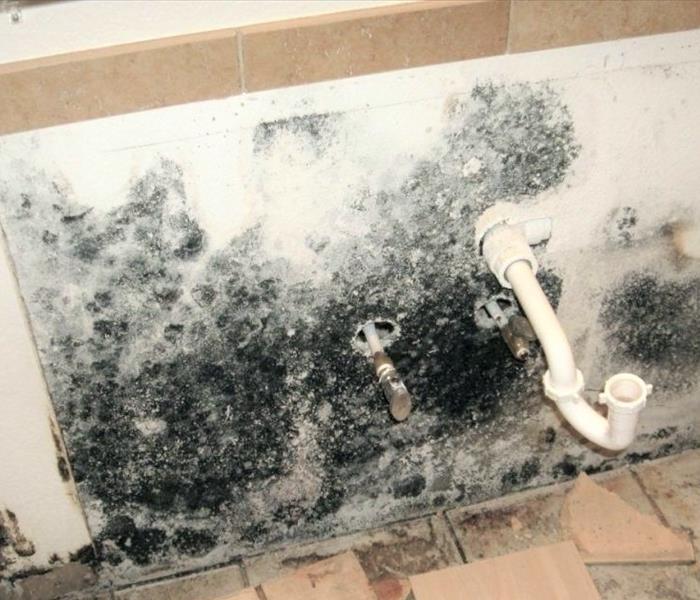 An unnoticed small leak behind a toilet bowl can cause a cause a big mold problem to Southbury area homes.
An unnoticed small leak behind a toilet bowl can cause a cause a big mold problem to Southbury area homes.
Moisture? Check.
Darkness? Check.
Heat? Check.
Porous material? Check.
When it comes to mold growth, the environment in a bathroom checks all of the boxes.
It is indeed the most common place that mold is spotted in residences. In fact, most bathrooms have some traces of mold. It is not a statement about the cleanliness of a house but rather just the nature of bathrooms themselves.
There are ways, however, to minimize your risk of mold growth in the bathroom.
Keep your eyes open for:
- Inadequate Ventilation: Be sure that the exhaust fan in your bathroom is in good working order. The steam created by hot showers and baths requires an exit route. Without one, all of the moisture from the water collects on the walls and ceiling of your bathroom.
- Leaky pipes: Pipes can leak under the sink as well as in the walls and go unnoticed, which allows mold to grow unchecked. Behind the walls, mold has all of the elements of life- water, dark and porous materials to grow on.
- Water leaks from shower doors and toilets: Is your shower door is malfunctioning and allow a little water out on a regular basis? Or maybe your toilet has a slow leak. Perhaps the kids splash water out of the tub that doesn’t get wiped up immediately. These can all allow the water to seep under the molding and into the walls and floor boards.
- Shower Tile: Inside the shower is a very common place for mold to grow due to the moisture and soap present. While mold might begin to grow on them, with vigilance this can typically be cleaned up by a homeowner.
The good news is that not all bathroom mold is toxic and not all bathroom mold requires professional mediation. Mold that is isolated to non-porous materials such as shower enclosures can be often be cleaned with water and mild detergent.
Mold that is found behind walls and on porous materials such as wood and sheetrock, however, requires professional remediation.
If you find mold in your bathroom, give the mold remediation team at SERVPRO of Southbury/Torrington a call at (203) 267-6262 to schedule a consultation.
Winter Weather Brings Mold Growth to Southbury Area Homes
12/19/2018 (Permalink)
 Ice dams can cause melting water to seep into ceilings and walls, creating favorable conditions for mold growth.
Ice dams can cause melting water to seep into ceilings and walls, creating favorable conditions for mold growth.
Winter brings snow and ice, which melt and can leak into homes, causing high levels of moisture. These conditions will lead to an increase in mold growth in homes and businesses.
Water that has leaked behind walls or seeped into basements unnoticed are often the common culprits, as is the high humidity that rainstorms bring.
There are some actions that our IICRC trained mold specialists suggest you take to reduce the likelihood of mold growing in your home.
- If you have one of the beautiful old Connecticut homes that has a dirt floor crawlspace, spread a moisture barrier down on the ground. Polyethylene or roofing paper will do the trick. This will help to reduce the moisture entering your crawlspace, and mold spores from entering your home.
- If there are any leaks coming from your roof and you cannot have it repaired until spring, cover it with a tarp to stop any water from entering.
- To stop any water from coming into your basement, grade the ground around your foundation to slope away. This will reduce the amount of water that is standing around your foundation and it's chances of entering your home.
- If you have a home that tends to get wet, be proactive after a rainstorm. Run dehumidifiers, heaters and fans in the vulnerable area if necessary.
- Keep an eye on windows and pipes for condensation, which can be caused by a leak or another source of high humidity in the room.
Mold spores can grow easily and spread fast in wet weather. If you see signs of mold after a flood or water damage this winter, give us a call to come out for an inspection. Catch it before it significantly spreads and the treatment process can be done with minimal impact to your life.
If You Suspect Mold in Your Torrington, CT Home, Take These Steps
8/23/2018 (Permalink)
 Mold on your windowsill is typically a sign that your window has a leaky seal. Call SERVPRO of Southbury/Torrington if you find mold in your home.
Mold on your windowsill is typically a sign that your window has a leaky seal. Call SERVPRO of Southbury/Torrington if you find mold in your home.
If you see visible mold, do not disturb it. You can inadvertently spread the mold infestation throughout your home. When mold is disturbed, the mold can release microscopic mold spores which become airborne and can circulate inside your home.
What to Do:
- Stay out of affected areas.
- Turn off the HVAC system and fans.
- Contact SERVPRO of Southbury/Torrington for mold remediation services.
What Not to Do:
- Don’t touch or disturb the mold.
- Don’t blow air across any surfaces with visible or suspected mold growth.
- Don’t attempt to dry the area yourself.
- Don’t spray bleach or other disinfectants on the mold.
About Our Mold Remediation Services
SERVPRO of Southbury/Torrington specializes in mold cleanup and restoration, in fact, it’s a cornerstone of our business. Our crews are highly trained restoration professionals that use specialized equipment and techniques to properly remediate your mold problem quickly and safely.
Some restoration companies advertise “mold removal” and may even guarantee to remove all mold. This is a fallacy because removing all mold from a house or business is impossible; microscopic mold spores exist almost everywhere, both indoors and outdoors. Here are the facts:
- Mold is present almost everywhere, indoors and outdoors.
- Mold spores are microscopic and float along in the air and may enter your home through windows, doors, or AC/heating systems or even hitch a ride indoors on your clothing or a pet.
- Mold spores thrive on moisture. Mold spores can quickly grow into colonies when exposed to water. These colonies may produce allergens and irritants.
- Before mold remediation can begin, any sources of water or moisture must be addressed. Otherwise, the mold may return.
- Mold often produces a strong, musty odor and can lead you to possible mold problem areas.
- Even higher-than-normal indoor humidity can support mold growth. Keep indoor humidity below 45 percent.
The sooner you address a potential mold problem at your home or business, the less invasive the clean up will be. If you see any suspicious growth or smell a musty, mildew scent in your kitchen or bathroom, call our Torrington office to schedule an appointment.
Signs of Mold Growth Behind the Walls of Your Southbury, CT Home
6/18/2018 (Permalink)
 When we lifted the wallpaper in this MIlford, CT home that had water damage from a water heater that leaked, we found mold.
When we lifted the wallpaper in this MIlford, CT home that had water damage from a water heater that leaked, we found mold.
It's not always obvious when your home has hidden mold. Unlike water or fire damage, mold damage can occur slowly and behind the walls of your home or business.
If your home has had water damage, it is likely that mold will start to grow in your walls or ceilings within 48 hours if the water wasn't removed. Drywall in particular will absorb water like a sponge very quickly and is an ideal surface for mold to grow on. If water damage in your home has soaked into your drywall, removal of the drywall is necessary to stop the possibility of mold growth. If your home has a slow leaking pipe, it could cause moist conditions behind your walls, allowing mold to grow.
There are some signs of mold that you you should be aware of.
- Damp or soft walls - Inspect your walls for any softness of the sheetrock, which could happen when it is deteriorating from the inside. Also, if your walls for damp to the touch, the cause should be determined.
- Warped walls - If your walls are bulging or warped, that could indicate moisture.
- Discoloration – Yellow, brown or black stains or rings on your walls are a sign of water damage from behind them.
- Peeling, bubbling or cracking of paint or wallpaper. We recently restored a home that had water damage in Milford, CT. The home had a hot water heater burst in the basement and although the water damage was discovered within 2 days, mold had begun to grow behind the wallpaper.
- Musty Smell - If you don’t see signs of mold but you can smell it, it may be hidden in your walls. The best way to describe a mold smell is that it is very earthy, similar to rotting leaves. If you think you smell mold in your home, taking a sniff around your electrical outlets may give you an idea of whether there may be a problem behind your walls.
If you suspect that you may have mold growing behind your walls, a consultation with a professional mold removal company is recommended. SERVPRO of Southbury/Torrington is IICRC certified in mold remediation and our crew uses the highest level of tools and training to determine whether mold exists in your home and how best to treat it.
Does Bleach Kill Mold Found in Your Home?
5/30/2018 (Permalink)
 Many customers ask us about using bleach on mold found in their homes. Here's why SERVPRO of Southbury/Torrington recommends against this practice.
Many customers ask us about using bleach on mold found in their homes. Here's why SERVPRO of Southbury/Torrington recommends against this practice.
When it comes to mold found inside of a home, there can be a lot of confusion. A google search will provide you with many conflicting "facts" and it's not always easy to determine what action you should take if you find mold in your home. In the next few weeks, we will be addressing some of the common misconceptions about mold to help you have a better understanding of it and its impact on your home and your health. Today, we address one of the most common myths about mold which is that bleach kills mold.
We understand how this myth originated. Bleach is an awesome disinfectant and was once recommended by both OSHA and the EPA as an effective mold remover. They have both since changed their recommendations and now advise against bleach for mold removal.
Bleach Cleans Only the Surface
To ensure survival, mold roots itself in porous materials like wood and sheetrock. Bleach does not penetrate deep into porous materials. Mold remediation requires a special cleaning process that reaches deep down into wood and other porous building materials to remove or "pull out" the roots. When bleach is applied, the mold might appear to be gone (since the surface was bleached white) however in a few weeks it reappears.
Bleach can be effective at removing surface mold on some hard, non-porous materials, such as tile and glass. So, if you need to use bleach on your bathtub or toilet bowl, go for it! Otherwise, consider an alternative treatment.
Bleach Feeds Mold, Adding to its Growth
What further exacerbates the situation is the fact that bleach is comprised 90% of water, which is essential for the growth of mold. So, the application of bleach actually feeds the mold spores and can allow it to grow even faster. Although the surface may look bleached and clean, the remaining spores will root deeper, stronger and will often return worse than before.
Bleach Damages Wood
Chlorine bleach is caustic and causes a chemical reaction that erodes and degrades the wood it has been applied to. The fibers are broken down and the structural integrity of your home can be compromised. You will be left with mold and damaged wood. This is not the result you were hoping for.
Mold Spores are in the Air
Bleach is not effective in killing mold spores, which are airborne. At SERVPRO of Southbury/Torrington, we use specialized filtration equipment, which allows our crew to capture microscopic mold spores out of the air. We utilize powerful “air scrubbers” and HEPA vacuums to prevent the spread of these mold spores while the mold remediation is in process.
For tips on preventing mold growth in your home, visit this page. If you have any questions about mold that you find in your Middlebury home, please feel free to call us at (203)267-6262.
Understanding Household Mold in Torrington, CT
4/29/2018 (Permalink)
 Finding mold in your Torrington CT home, and understanding the mold remediation process, should not be stressful.
Finding mold in your Torrington CT home, and understanding the mold remediation process, should not be stressful.
Finding mold in a home can bring concern and worry to a homeowner. We receive frequent calls at our office from people who have found mold. These callers are often filled with questions about our mold remediation process. The truth is, mold does not have to be complicated. There a few basic concepts about mold and how it is treated that are good for homeowners to know prior to contacting a mold remediation company.
1. You will hear many different terms used for the treatment of mold in the home including mold removal, mold abatement, mold remediation and mold mitigation. These terms are interchangeable. Because they naturally occur in both indoor and outdoor environments, mold spores are always present in a home. Any company that claims to eliminate mold from your home is probably one to stay clear of. The goal when servicing a home that has mold is the reduction of mold spores to healthy, natural levels.
2. Many internet sources warn of black mold and indicate that it is more harmful than other molds. Black mold, or Stachybotrys chartarum, can cause a range of negative health symptoms on humans. However, not all mold that is colored black produces mycotoxins, which are a toxic substance produced by mold. And many of the 100,000 species of mold that are different colors do produce mycotoxins. So, don't let the color of the mold in your home affect your decision to have it inspected and treated.
3. Mold does not always require professional remediation. We visit homes on a regular basis to inspect reports of mold. Quite often, we are able to locate the source of the moisture (typically a pipe leak under a sink or a roof leak) and suggest that the homeowner call a plumber to repair the leak. When we inspect a home for mold, we always give an honest opinion as to whether our services are needed.
If you do require mold remediation, a highly trained mold specialist is required. The team at SERVPRO of Southbury/Torrington is IICRC trained for mold and has the experience and equipment needed to safely mitigate the mold in your home.
Basements, Attics and Leaky Pipes: The Causes of Mold Growth in Litchfield County Homes
3/22/2018 (Permalink)
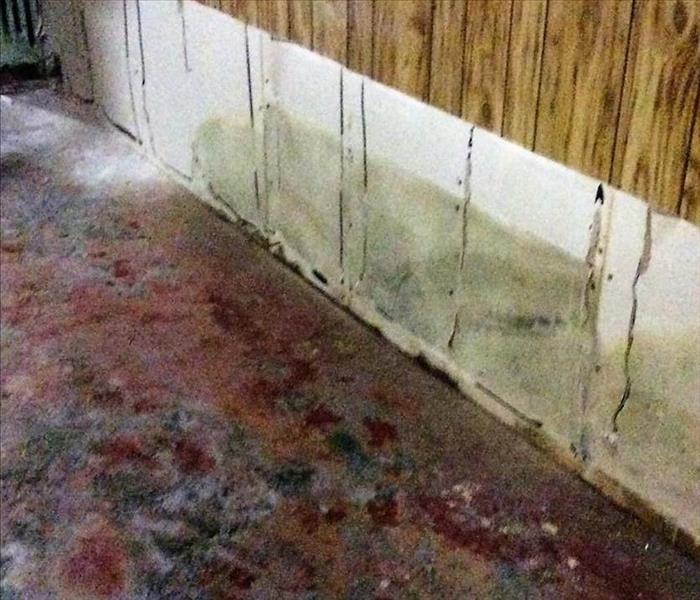 This home had mold covering the walls and floors of the basement family room. The mold was found under carpeting and behind paneling on the walls.
This home had mold covering the walls and floors of the basement family room. The mold was found under carpeting and behind paneling on the walls.
At SERVPRO of Southbury/Torrington, we talk with many homeowners who are concerned when they discover mold in their home.
There has been quite a bit of attention on mold in homes and the potential health hazards of black mold lately. Mold exists naturally in our environment and is not harmful at regular levels. It's when mold has the opportunity to grow at a rapid rate that it becomes of concern.
In order to grow, mold requires certain conditions to be met. Mold spores need to be present and have a food source (examples would be cotton, sheetrock, plywood, etc.). In addition, mold requires darkness, oxygen and warm temperatures. However, these are typical conditions in most homes. The factor that most determines whether mold will grow in your home is moisture.
Some of the most common causes of residential mold damage are:
Leaky Pipes: A slow leak might not be obvious to a homeowner but over time can create an environment that is ideal for mold growth. We have responded to a number of jobs in Litchfield County in which a plumber has discovered mold behind the kitchen cabinets due to a leaking pipe. In these cases, the kitchen cabinetry as well as walls and flooring often requires removal.
The fix: Periodically check pipes, walls and cabinetry for any signs of leaking.
Attic Mold: In order to keep moisture levels low in an attic, it must be ventilated properly. A well-ventilated attic will allow warm air to escape through the peak of the roof via the ridge and soffit vents. Another reason for moisture in an attic can be a roof leak.
The fix: Have your ridge and soffit vents checked for blockages and inspect your roof and attic for leaks.
Basement Mold: Due to low sunlight, condensation, high humidity, flooding and leaks, the basement is a common location for mold growth. In addition, people spend little time in their basement and are less likely to spot it early on.
The fix: If there is flooding, have your basement waterproofed. Keep humidity levels down with a dehumidifier. Repair any leaky pipes. If there is water at your house's foundation, it may be necessary for ditches and drains to be built to protect your Harwinton home.
The good news is, not all mold requires professional remediation.
If you spot mold in your Torrington area home, give us a call at 203-267-6262. Our mold specialists are IICRC certified and have over 20 years of experience inspecting mold and will give you an honest assessment of whether mold remediation is required.
Microscopic Mold Spores
1/4/2018 (Permalink)
Microscopic mold spores naturally occur almost everywhere. This makes it impossible to remove all mold from one’s residence or business.
Therefore, mold remediation reduces the mold spore count back to its natural or baseline level.
Some restoration businesses advertise “mold removal” and even guarantee to remove all mold, which is a fallacy. Consider the following mold facts:
- Mold is present almost everywhere, indoors and outdoors.
- Mold spores are microscopic and float along in the air and may enter your home through windows, doors, or AC/heating systems or even hitch a ride indoors on your clothing or a pet.
- Mold spores thrive on moisture. Mold spores can quickly grow into colonies when exposed to water. These colonies may produce allergens and irritants.
- Before mold remediation can begin, any sources of water or moisture must be addressed. Otherwise, the mold may return.
- Mold often produces a strong, musty odor and can lead you to possible mold problem areas.
- Even higher-than-normal indoor humidity can support mold growth. Keep indoor humidity below 45 percent.
If you see signs of mold, please contact SERVPRO of Southbury/Torrington at 203-267-6262. We are here to help and have specialized equipment and expertise to help remediate your mold infestation.
Does Insurance Cover Mold?
1/4/2018 (Permalink)
On a weekly basis we are called in to inspect mold. With much attention around black mold and its potential to be toxic to one’s health, many homeowners’ don't want to take a chance when they see mold. However, not every home that we inspect requires professional remediation. Often enough, we recommend a safe method in which homeowner's can reduce their mold exposure and/or treat it themselves.
In the cases where there has been a mold infestation and our services were required, homeowners were surprised when their home-owner’s insurance did not cover mold remediation.
Some policies will cover mold under certain circumstances, while other policies may exclude mold. Typically, if your policy does not include mold remediation it can be added. However, we recommend that you call your insurance agent to learn more about mold coverage. It can be a preventative measure that can save you thousands.
If you see signs of mold please don’t hesitate to call SERVPRO of Southbury/Torrington at (203) 267-6262.
Safety Precautions When Dealing With Mold
11/28/2017 (Permalink)
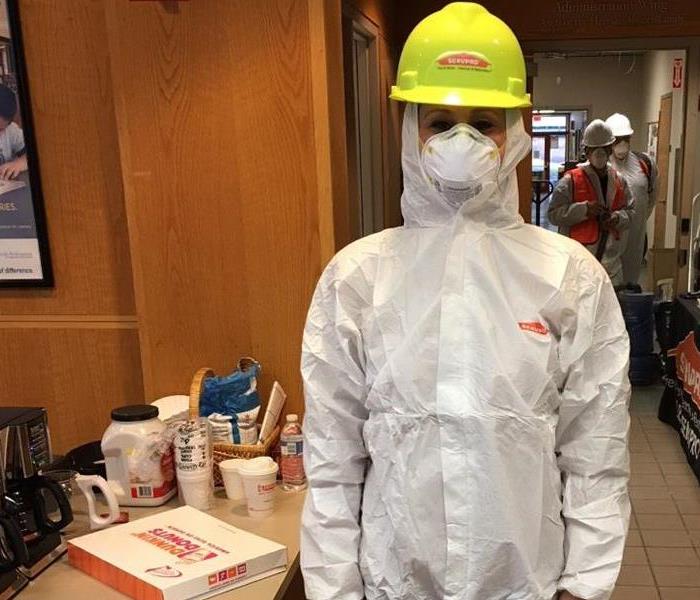 Gearing up!
Gearing up!
SERVPRO of Southbury/Torrington follows strict protocols when removing mold. We are a group of highly trained professional ready to restore your property back to pre-disaster conditions, if not better! We are the experts in mold remediation and restoration for residential and commercial properties.
It is important that safety precautions are used when dealing with any size disaster, especially when dealing with mold. Water & Mold losses have the potential to cause major damage to structures if not handled properly. Cleanup can be extremely overwhelming, so let us help you take back control of your property. We are available, prepared and here to handle in any size disaster 24/7.
Should you suspect mold, visit us online or call us call us at 203-267-6262.
10 Things to Know About Mold
11/27/2017 (Permalink)
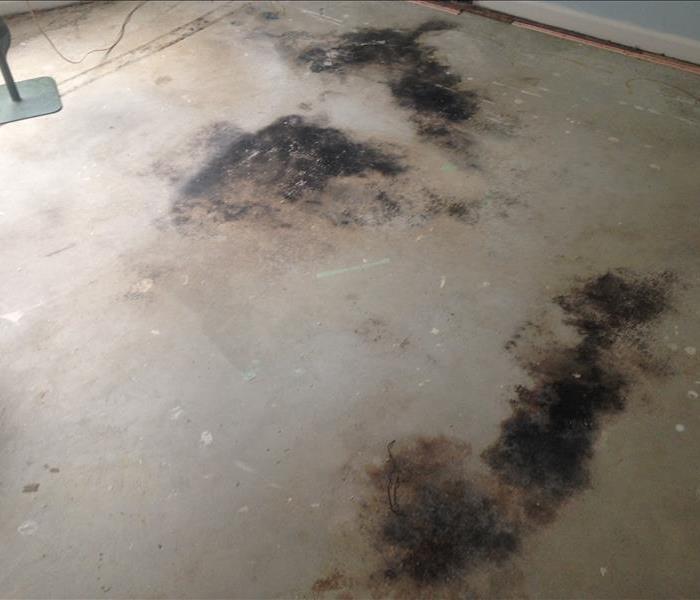 Black Mold
Black Mold
10 Things to Know About Mold
According to the United States Environmental Protection Agency (EPA), there are 10 things you should know about mold:
- Potential health effects.
- No practical way to eliminate mold; the best way is through moisture control.
- If mold becomes a problem, you must clean up mold and eliminate the source of moisture.
- To prevent mold growth, find the source and fix the issue.
- Reduce indoor humidity by venting bathrooms, dryers and other moisture sources outside. Use air conditioners and de-humidifiers.
- Clean and dry damp or wet materials quickly to prevent mold growth.
- Should mold be present, clean surfaces with detergent and dry completely. Materials like ceiling tiles, sheet rock and etc, should be replaced.
- Prevent condensation.
- In areas where there is a moisture problem, do not install carpeting.
- Mold can be found almost anywhere and can grow on just about anything.
For more information on mold visit
Steps To Help Minimize Your Risk To Mold In Your Home
11/27/2017 (Permalink)
Steps to help minimize your risk to mold in your home:
- Caulk around water fixtures – this includes, sink, shower, toilet, and windows.
- Use mold inhibiting paints in bathroom and other damp areas
- Use a fan in the bathroom which exhausts outdoors
- Vent clothes dryer outside
- Clean refrigerator and air conditioner drip pans
- Don’t for get to clean your gutters – standing water in your gutters can leak into the eaves and potentially exterior walls.
- Roof – check the attic for roof leaks
- Basement and crawl space – check for moisture or standing water. Consider using a dehumidifier in your basement.
- Consider sealing dirt basement and crawl spaces.
- Water damage - clean it up immediately.
Should you experience a water loss please contact experts who specializes in water & mold mitigation. They will properly extract and dry out the affected areas. Even minor floods have the potential to cause major damage to a structure when not treated properly. Cleanup can often be an overwhelming task, so call SERVPRO of Southbury/Torrington, we are prepared to handle any size disaster.
Local Business Experiences Mold
11/27/2017 (Permalink)
 Mold growth behind sheet rock wall.
Mold growth behind sheet rock wall.
This is a picture from a local business that experienced mold growth behind sheet rock wall which neighbors to another business. Overtime, the business owner noticed a strong musty odor and decided to further investigate. After moving around large bulky furniture, they noticed a discoloration and bulge in the sheet rock and thereafter, called SERVPRO of Southbury/Torrington. We arrived on scene and carefully inspected for any visible signs of mold. Our workers set up containment procedures to keep the mold spores from spreading during the cleanup process. We also set up equipment like air scrubbers and HEPA vacuums which captured the microscopic mold spores from spreading while remediation was in process.
Also, we used an anti fungal and antimicrobial treatment to eliminate mold from forming and disposed of the heavy contaminated mold growth materials. Lastly, restoration begins; we replaced drywall, re-painted and gave them a fresh clean look.
Should you suspect mold, please contact us immediately. Minor losses have the potential to cause major damages when not treated properly. Cleanup can often be an overwhelming task; however, we are prepared 24/7 to handle any size disaster.




 24/7 Emergency Service
24/7 Emergency Service